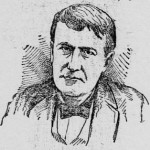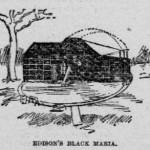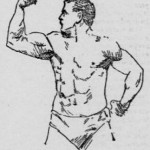Source: George M. Smith, ‘Edison’s Latest Invention’, St. Paul Daily Globe, 8 April 1894, p. 18
Text: EDISON’S LATEST INVENTION.
The Kinetoscope and the Marvels it Accomplishes.
INTERESTING CHAT WITH THE WIZARD.
He Calls His Latest Work a Toy But Grows Enthusiastic Over What he Hopes to do With it in the Future — Some of its Uses Forecast by the Wizard
“The kinetoscope does for the eye what the phonograph does for the ear.” That is a phrase which has often been on the lips of Thomas A. Edison during the past several weeks, and it conveys an idea which has been very much in his mind for several years. It is a perfect epigrammatic definition of his latest invention, for it is a fact that the kinetoscope reproduces the eye effect of motion just as the phonograph reproduces to the ear the effect of sound. How this is done and what the machine that does it is like, it is the purpose of this article to tell.
Several days ago the writer called by appointment at the Edison laboratory in West Orange, N. J., and sent his card up to Mr. Edison. Mr. Edison sent back word that W.K.L. Dickson would show and explain the kinetosoope to me and that afterward he himself would talk with me about it. Mr Dickson is one of Mr. Edison’s right-hand men, and a history of the kinetoscope would be incomplete without seme account of his connection with it. He is an electrical engineer, and has had much to do with the development of the ore separator on which Mr. Edison is now working. He is also a fine chemist, and one of the greatest experts in photography in the world. A fine biography of Mr. Edison has recently come from his pen and that of his sister, Miss Antonia Dickson. Between six and seven years ago Mr. Edison formulated the problem the result of which is the kinetoscope, and communicated it to Mr. Dickson. Since then they have been developing the idea, and although their experiments are not yet carried to their conclusion, they have reached a point where Mr. Edison is willing that the public should see what they have done.

Mr. Dickson greeted me cordially, and pointed to an oak cabinet standing in the middle of one of the rooms of the photograph department. It was the kinetoscope. In appearance it is very like the nickel-in-the-slot phonograph, with which most people are already familiar. If an oak parlor organ with the keys covered were reduced some what in size, it would look somewhat like the kinetoscope. Mr. Dickson took a piece of brass exactly the size of a nickel and dropped it into the slot, while I looked into a glass in top. An electric light was burning inside, and the noise of rapidly running machinery was audible. The scene that was reproduced was that of a barber shop, and a placard on the wall informed the observer that it was “The Latest Wonder, Shave and Haircut for a Nickel.” It pictured a man being shaved while two others sat by and enjoyed a joke which one of them had discovered in a comic paper. All the movements of the different persons seen were reproduced clearly and precisely as they took place before the camera. This is the picture that has been shown oftenest to those who have looked into the kinetoscope. Many other pictures are ready to be put into the marvelous instrument, and before long twenty-five of the machines will have been sold and stationed in public places, where any one may enjoy thorn for five cents a look.
The kinetoscope is a sequel to the kinetograph, the invention of which was announced some time ago. The business of the kinetograph is to take the pictures, and the function of the kinetoscope is to display them to the eye, one after another, so rapidly that they all seem like one scene, with the figures moving about as they do in actual life. The forerunner of these inventions was the zoetrope, a child’s toy which passed before the gaze of the beholder four pictures in a second, and created a semblance of the effect of motion. Then Muybridge got a battery of cameras that would take from eighteen to twenty impressions in a second. But neither of these was quick enough to deceive the human eye – that is to say, if eighteen or twenty pictures a second were presented to the sight the eye could easily detect when one went and another came. Mr. Edison discovered that, in order to create the illusion of a stationary or continuous picture, forty-six views would have to be presented every second, and each one of them would have to pause about the one-forty-sixth part of a second, and then be replaced by the next in the one hundred and eighty-fifth part of a second. This is the rate at which the impressions are received by the kinetograph, and reproduced by the kinetoscope. In the kinetoscope every picture must stop in exactly the same place as every other picture. If it did not there would be a tremor which the eye would notice, and the illusion would be dispelled.

Suppose, for example, it were desired to show a man in the act of taking a step. While he was moving his foot through the air a number of pictures would be recorded, each one of which would show the foot and the whole of his body in a slightly different position, as the step progressed. The series of pictures would be passed before the eye so rapidly that only one picture would appear, and there would be a perfect reproduction of the step.
The kinetoscope runs about thirty seconds every time a nickel is dropped into it, and in that time, it will be seen, more than a thousand separate views are slid under the little glass window in the top.
As we left the building in which the kinetoscope stood Mr. Dickson pointed to the remarkable photographic theatre in which the kinetograph does its work. It is called the “Black Maria,” and it is so arranged upon a pivot and a track that one can easily move lt around to the position required to meet the light of the sun. We then walked to the room on the second floor of the laboratory in which Mr. Edison was sitting.
He was deep in thought, and did not seem to notice that we had entered; but when Mr. Dickson spoke to him he drew two chairs close together, sat down on one, bade me me seated on the other, and signified that he was ready to be questioned.
It is said to be a peculiarity of Mr. Edison’s habit of thought that he cares comparatively little for what he has done, and dwells with pleasure on the prospect of what he is about to do. This would seem, to be true with regard to his estimate of the kinetoscope. He speaks of the nickel-in-the-slot machine that we have just been considering as though it were a mere toy, but becomes enthusiastic in unfolding the future greatness of the invention.
“Mr. Edison,” said I, “what do you expect to accomplish in the development of the kinetoscope?”
“I expect to be able to reproduce a whole opera, showing the people on the stage in their natural size and moving around, and to make their voices heard just they sang and talked. I expect to be able to show any celebrated orator on the platform delivering a speech, so that people may see how lie looked and acted and hear the sound of his voice. This I will do by throwing the scenes from the kinetoscope on a large screen by means of a stereopticon, and having the sounds issue from a phonograph at tho proper moment to comport with the movements of those who made them.
“I may say that this has already been done. Down in the library perhaps you noticed a large white screen, extending across one end of the room, wound upon a ratchet roller. I have also a stereopticon, and with these, the kinetoscope and the phonograph, we have reached some very satisfactory results. It will be some time, however, before we secure that absolute perfection which we aim to achieve before we give any public exhibitions. You should see the figures on the screen,” said he, with a glow of pardonable pride, showing that he contemplated that part of his work with sincere pleasure.
“The pictures that are taken at present for the kinetoscope are one inch by three-quarters of an inch in size. The difficulty increases with the dimensions of the picture, because the larger the picture is the further it must move during the fraction of a second that elapses between the time one view disappears and another takes its place. We expect, however, to be able to work successfully with pictures at inch and a half high, and that, we think, will be the limit of the possibilities of the kinetoscope.”
“Do you expect to make any money out of this invention?”
“No, I do not see where there is anything to be made out of it. I have been largely influenced by sentiment in the prosecution of this design. But, said he, with a merry twinkle in his eye, “as I have no steam yacht, or fast horses, or anything of that sort, I thought I could afford to sink a little money in the kinetoscope.
“Although it occurred to me six or seven years ago that something might be done in this way, the broad idea, as I have stated it to you, came to me only four or five years ago, and for the past two years we have been working at it diligently. My. first experiments in this direction were conducted with a phonograph and a micro-camera.
“That little nickel-in-the-slot affair is only intended to let the people know what our ideas is.”
Two men engaged in wrestling are shown in one of the series of illustrations that accompany the kinetoscope. They were photographed in the “Black Maria” by the kinetograph and the kinetoscope portrays the whole bout from beginning to end, with every move that the wrestlers made. As the struggle carried them about over considerable space they were placed at quite a distance from the camera, and their figures are smaller than those of Sandow, which form another series of illustrations.

Sandow, the strong man, is an intimate friend of Mr. Dickson, which accounts for his being the first celebrity to have his fame perpetuated by the kinetoscope. The picture shown herewith is only one of a hundred of which include Sandow’s complete performance. It has been stated that Sandow was photographed while holding Mr. Edison out at arm’s length with one finger, but this is not true. Sandow could easily have done it, even had Mr. Edison been a much heavier man than he is, and during his visit to the laboratory it was suggested that such a picture should be taken, but for some, reason or other the idea was not carried out.
During the experiments that were made with the kinetograph an incident occurred that was calculated to test the nerves of those who took, part in it. It was decided to attempt to photograph a bullet fired from a rifle while it was flying through the air, and this was accomplished; but as the same thing has been done by others, Mr. Edison and Mr. Dickson claim no credit for originality in their success. A bullet was heated white-hot, and a charge of powder was poured into a rifle barrel. The bullet was then put into the muzzle of the gun and allowed to roll until it reached the powder, which instantly ignited and sent the ball flying through the room within range of the kinetograph. This delicate operation had to be repeated three times before a good impression could be obtained, and, as may be imagined, it was mighty ticklish business.
These inventions, the kinetograph, the kinetoscope and the phono-kinetoscope, put Mr. Edison as certainly in the foremost place among photographers and electro-photographers as the other products of his genius entitle him to rank first in the school of electricians. It is difficult, while the revelation is fresh in our thoughts and new to our understanding, to estimate what the kinetoscope will contribute to the progress of science and the education of man. It will disclose movements that hitherto have eluded the eye, and as to which speculation has been misleading, and it will make the great leaders of the present live again in the future as their contemporaries see and know them. What other uses will be found for it it is too early to say. That it will enhance Mr. Edison’s fame and increase the sum of the world’s debt to him is beyond question.
Comment: This is a typical example of the many eulogistic reports of the Kinetoscope peepshow which appeared in the American press around this time. It was syndicated across several newspapers. The Kinetoscope was launched commercially shortly after this article, at a parlour opened by the Holland brothers at 1155 Broadway, New York on 14 April 1894. The films referred to in this article are Barber Shop (1893), Wrestling Match (1894) and Sandow (1894). Eugen Sandow was a renowned bodybuilder. William Kennedy-Laurie Dickson was Edison’s principal engineer working on motion picture devices. The images of Edison, the Black Maria and Sandow all feature in the original article, which was published in St Paul, Minnesota.
Links: Copy on Chronicling America


